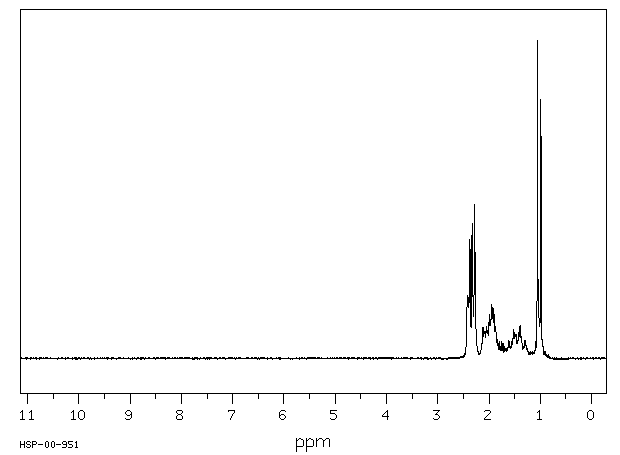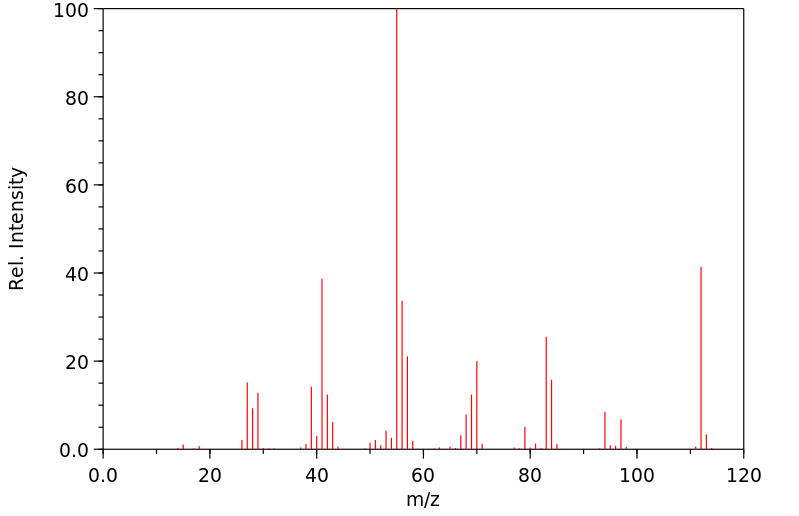4-甲基环己酮 | 589-92-4
-
物化性质
-
计算性质
-
ADMET
-
安全信息
-
SDS
-
制备方法与用途
-
上下游信息
-
文献信息
-
表征谱图
-
同类化合物
-
相关功能分类
-
相关结构分类
物化性质
-
熔点:-41 °C
-
沸点:169-171 °C (lit.)
-
密度:0.914 g/mL at 25 °C (lit.)
-
闪点:105 °F
-
介电常数:12.4
-
LogP:1.33 at 20℃
-
物理描述:Liquid
-
溶解度:insoluble in water; soluble in oils
-
蒸汽压力:1.50 mmHg
-
折光率:1.441-1.452
-
保留指数:923;936;939;943;945;954;918;937;945
-
稳定性/保质期:
计算性质
-
辛醇/水分配系数(LogP):1.4
-
重原子数:8
-
可旋转键数:0
-
环数:1.0
-
sp3杂化的碳原子比例:0.857
-
拓扑面积:17.1
-
氢给体数:0
-
氢受体数:1
ADMET
安全信息
-
TSCA:Yes
-
危险等级:3
-
危险品标志:Xn
-
安全说明:S16,S23,S36,S36/37
-
危险类别码:R20/21/22,R10
-
WGK Germany:1
-
海关编码:29142200
-
危险品运输编号:UN 2297 3/PG 3
-
危险类别:3
-
RTECS号:GW1750200
-
包装等级:III
-
危险性防范说明:P305+P351+P338
-
危险性描述:H225,H302
-
储存条件:| 易燃区域 |
SDS
模块 1. 化学品
1.1 产品标识符
: 4-甲基环己酮
产品名称
1.2 鉴别的其他方法
Tetrahydro-p-cresol
1.3 有关的确定了的物质或混合物的用途和建议不适合的用途
仅用于研发。不作为药品、家庭或其它用途。
模块 2. 危险性概述
2.1 GHS-分类
易燃液体 (类别 3)
急性毒性, 经口 (类别 4)
2.2 GHS 标记要素,包括预防性的陈述
象形图
警示词 警告
危险申明
H226 易燃液体和蒸气
H302 吞咽有害。
警告申明
预防措施
P210 远离热源、火花、明火和热表面。- 禁止吸烟。
P233 保持容器密闭。
P240 容器和接收设备接地。
P241 使用防爆的电气/ 通风/ 照明 设备。
P242 只能使用不产生火花的工具。
P243 采取措施,防止静电放电。
P264 操作后彻底清洁皮肤。
P270 使用本产品时不要进食、饮水或吸烟。
P280 戴防护手套/穿防护服/戴护目镜/戴面罩.
事故响应
P301 + P312 如果吞咽并觉不适: 立即呼叫解毒中心或就医。
P303 + P361 + P353 如果皮肤(或头发)接触:立即除去/脱掉所有沾污的衣物,用水清洗皮肤/淋
浴。
P330 漱口。
P370 + P378 火灾时: 用干的砂子,干的化学品或耐醇性的泡沫来灭火。
安全储存
P403 + P235 保持低温,存放于通风良好处。
废弃处置
P501 将内容物/ 容器处理到得到批准的废物处理厂。
2.3 其它危害物 - 无
模块 3. 成分/组成信息
3.1 物 质
: Tetrahydro-p-cresol
别名
: C7H12O
分子式
: 112.17 g/mol
分子量
组分 浓度或浓度范围
4-Methylcyclohexanone
<=100%
化学文摘登记号(CAS 589-92-4
No.) 209-665-3
EC-编号
模块 4. 急救措施
4.1 必要的急救措施描述
一般的建议
请教医生。 向到现场的医生出示此安全技术说明书。
吸入
如果吸入,请将患者移到新鲜空气处。 如呼吸停止,进行人工呼吸。 请教医生。
皮肤接触
用肥皂和大量的水冲洗。 请教医生。
眼睛接触
用水冲洗眼睛作为预防措施。
食入
禁止催吐。 切勿给失去知觉者通过口喂任何东西。 用水漱口。 请教医生。
4.2 主要症状和影响,急性和迟发效应
据我们所知,此化学,物理和毒性性质尚未经完整的研究。
4.3 及时的医疗处理和所需的特殊处理的说明和指示
无数据资料
模块 5. 消防措施
5.1 灭火介质
灭火方法及灭火剂
用水雾,抗乙醇泡沫,干粉或二氧化碳灭火。
5.2 源于此物质或混合物的特别的危害
碳氧化物
5.3 给消防员的建议
如必要的话,戴自给式呼吸器去救火。
5.4 进一步信息
用水喷雾冷却未打开的容器。
模块 6. 泄露应急处理
6.1 作业人员防护措施、防护装备和应急处置程序
使用个人防护用品。 避免吸入蒸气、烟雾或气体。 保证充分的通风。 移去所有火源。
谨防蒸气积累达到可爆炸的浓度。蒸气能在低洼处积聚。
6.2 环境保护措施
如能确保安全,可采取措施防止进一步的泄漏或溢出。 不要让产品进入下水道。
6.3 泄漏化学品的收容、清除方法及所使用的处置材料
围堵溢出,用防电真空清洁器或湿刷子将溢出物收集起来,并放置到容器中去,根据当地规定处理(见第13部
分)。
6.4 参考其他部分
丢弃处理请参阅第13节。
模块 7. 操作处置与储存
7.1 安全操作的注意事项
避免接触皮肤和眼睛。 避免吸入蒸气和烟雾。
切勿靠近火源。-严禁烟火。采取措施防止静电积聚。
7.2 安全储存的条件,包括任何不兼容性
贮存在阴凉处。 使容器保持密闭,储存在干燥通风处。
打开了的容器必须仔细重新封口并保持竖放位置以防止泄漏。
7.3 特定用途
无数据资料
模块 8. 接触控制和个体防护
8.1 容许浓度
最高容许浓度
没有已知的国家规定的暴露极限。
8.2 暴露控制
适当的技术控制
根据良好的工业卫生和安全规范进行操作。 休息前和工作结束时洗手。
个体防护设备
眼/面保护
面罩與安全眼鏡请使用经官方标准如NIOSH (美国) 或 EN 166(欧盟) 检测与批准的设备防护眼部。
皮肤保护
戴手套取 手套在使用前必须受检查。
请使用合适的方法脱除手套(不要接触手套外部表面),避免任何皮肤部位接触此产品.
使用后请将被污染过的手套根据相关法律法规和有效的实验室规章程序谨慎处理. 请清洗并吹干双手
所选择的保护手套必须符合EU的89/686/EEC规定和从它衍生出来的EN 376标准。
身体保护
全套防化学试剂工作服, 阻燃防静电防护服,
防护设备的类型必须根据特定工作场所中的危险物的浓度和数量来选择。
呼吸系统防护
如危险性评测显示需要使用空气净化的防毒面具,请使用全面罩式多功能防毒面具(US)或ABEK型
(EN
14387)防毒面具筒作为工程控制的候补。如果防毒面具是保护的唯一方式,则使用全面罩式送风防
毒面具。 呼吸器使用经过测试并通过政府标准如NIOSH(US)或CEN(EU)的呼吸器和零件。
模块 9. 理化特性
9.1 基本的理化特性的信息
a) 外观与性状
形状: 透明, 液体
颜色: 淡黄
b) 气味
无数据资料
c) 气味阈值
无数据资料
d) pH值
无数据资料
e) 熔点/凝固点
无数据资料
f) 沸点、初沸点和沸程
169 - 171 °C - lit.
g) 闪点
48 °C - 闭杯
h) 蒸发速率
无数据资料
i) 易燃性(固体,气体)
无数据资料
j) 高的/低的燃烧性或爆炸性限度 无数据资料
k) 蒸气压
无数据资料
l) 蒸汽密度
无数据资料
m) 密度/相对密度
0.914 g/cm3 在 25 °C
n) 水溶性
无数据资料
o) n-辛醇/水分配系数
无数据资料
p) 自燃温度
无数据资料
q) 分解温度
无数据资料
r) 粘度
无数据资料
模块 10. 稳定性和反应活性
10.1 反应性
无数据资料
10.2 稳定性
无数据资料
10.3 危险反应
无数据资料
10.4 应避免的条件
热,火焰和火花。
10.5 不相容的物质
强氧化剂, 强还原剂, 强碱
10.6 危险的分解产物
其它分解产物 - 无数据资料
模块 11. 毒理学资料
11.1 毒理学影响的信息
急性毒性
半数致死剂量 (LD50) 经口 - 大鼠 - 800 mg/kg
皮肤刺激或腐蚀
无数据资料
眼睛刺激或腐蚀
无数据资料
呼吸道或皮肤过敏
无数据资料
生殖细胞致突变性
无数据资料
致癌性
IARC:
此产品中没有大于或等于 0。1%含量的组分被 IARC鉴别为可能的或肯定的人类致癌物。
生殖毒性
无数据资料
特异性靶器官系统毒性(一次接触)
无数据资料
特异性靶器官系统毒性(反复接触)
无数据资料
吸入危险
无数据资料
潜在的健康影响
吸入 吸入可能有害。 可能引起呼吸道刺激。
摄入 误吞对人体有害。
皮肤 通过皮肤吸收可能有害。 可能引起皮肤刺激。
眼睛 可能引起眼睛刺激。
接触后的征兆和症状
据我们所知,此化学,物理和毒性性质尚未经完整的研究。
附加说明
化学物质毒性作用登记: GW1750200
模块 12. 生态学资料
12.1 生态毒性
无数据资料
12.2 持久性和降解性
无数据资料
12.3 潜在的生物累积性
无数据资料
12.4 土壤中的迁移性
无数据资料
12.5 PBT 和 vPvB的结果评价
无数据资料
12.6 其它不良影响
无数据资料
模块 13. 废弃处置
13.1 废物处理方法
产品
在装备有加力燃烧室和洗刷设备的化学焚烧炉内燃烧处理,特别在点燃的时候要注意,因为此物质是高度易燃
性物质 将剩余的和不可回收的溶液交给有许可证的公司处理。
受污染的容器和包装
按未用产品处置。
模块 14. 运输信息
14.1 联合国危险货物编号
欧洲陆运危规: 2297 国际海运危规: 2297 国际空运危规: 2297
14.2 联合国运输名称
欧洲陆运危规: METHYLCYCLOHEXANONE
国际海运危规: METHYLCYCLOHEXANONE
国际空运危规: Methylcyclohexanone
14.3 运输危险类别
欧洲陆运危规: 3 国际海运危规: 3 国际空运危规: 3
14.4 包裹组
欧洲陆运危规: III 国际海运危规: III 国际空运危规: III
14.5 环境危险
欧洲陆运危规: 否 国际海运危规 国际空运危规: 否
海洋污染物(是/否): 否
14.6 对使用者的特别提醒
无数据资料
模块 15 - 法规信息
N/A
模块16 - 其他信息
N/A
制备方法与用途
上下游信息
-
上游原料
中文名称 英文名称 CAS号 化学式 分子量 3-甲基环己酮 3-Methylcyclohexanone 591-24-2 C7H12O 112.172 2-甲基环己酮 2-Methylcyclohexanone 583-60-8 C7H12O 112.172 -
下游产品
中文名称 英文名称 CAS号 化学式 分子量 3-甲基环己酮 3-Methylcyclohexanone 591-24-2 C7H12O 112.172 2-甲基环己酮 2-Methylcyclohexanone 583-60-8 C7H12O 112.172 —— 4-Methyl-cycloheptanon 5452-36-8 C8H14O 126.199 2,4-二甲基环己烷-1-酮 2,4-dimethylcyclohexanone 823-55-2 C8H14O 126.199 —— 2,4,6-trimethylcyclohexanone 90645-54-8 C9H16O 140.225 2,5-二甲基环己酮 2,5-dimethylcyclohexanone 932-51-4 C8H14O 126.199 4-甲基环己烷-1,2-二酮 4-methyl-1,2-cyclohexanedione 3008-42-2 C7H10O2 126.155 —— 2-ethyl-4-methyl-cyclohexanone 115684-76-9 C9H16O 140.225 —— 2,6-diethyl-4-methyl-cyclohexanone 861574-47-2 C11H20O 168.279 —— 2,5-Dimethyl-cycloheptanon 103260-99-7 C9H16O 140.225 环庚酮 cycloheptanone 502-42-1 C7H12O 112.172 —— (4-methyl-cyclohexyl)-acetone 94073-11-7 C10H18O 154.252 —— 4-Methyl-2-formyl-cyclohexanon 26706-86-5 C8H12O2 140.182 —— (trans)-4-methylcyclohexanecarbaldehyde 7133-05-3 C8H14O 126.199 —— 4-methylcyclohexanecarbaldehyde 33242-79-4 C8H14O 126.199 —— 4-methyl-4-fluorocyclohexanone 82953-31-9 C7H11FO 130.162 1-甲基-4-氧代环己烷-1-腈 1-methyl-4-oxocyclohexane-1-carbonitrile 121955-82-6 C8H11NO 137.181 1-(4-甲基环己基)乙酮 4-acetyl-1-methylcyclohexane 1879-06-7 C9H16O 140.225 —— 3-(5-methyl-2-oxocyclohexyl)propanenitrile 83377-49-5 C10H15NO 165.235 —— 5,4'-dimethyl-bicyclohexyl-2-one 92370-62-2 C14H24O 208.344 —— (-)-2(R)-Cyanoethyl-4(S)-methylcyclohexanon —— C10H15NO 165.235 - 1
- 2
- 3
反应信息
-
作为反应物:描述:参考文献:名称:Betts; Plant, Journal of the Chemical Society, 1928, p. 2073摘要:DOI:
-
作为产物:描述:bis-(4-methyl-cyclohexylidene)-hydrazine 在 HOF* CH3CN 作用下, 以 二氯甲烷 为溶剂, 反应 0.02h, 以80%的产率得到4-甲基环己酮参考文献:名称:一种新的有效脱保护嗪,和肟的方法。交换羰基中氧同位素的绝佳途径摘要:可以通过HOF·CH 3 CN在几秒钟内将HOS·CH 3 CN脱保护为相应的酮或醛,从而获得非常好的收率,从而可以保护作为嗪或其他CN衍生物的羰基。该反应还提供了一种非常有效的途径,可以用任何其他氧同位素(例如[18] O)取代大多数羰基的氧原子。DOI:10.1016/j.tetlet.2005.11.090
-
作为试剂:描述:参考文献:名称:使用 [双(乙酰氧基)碘] 苯和乙酸乙酯中的溴离子催化量氧化醇的简单程序摘要:通过使用 [双(乙酰氧基)碘] 苯 (BAIB) 和催化量的溴离子,来自四丁基溴化铵或 KBr,在乙酸乙酯中,伯和仲苯甲醇和仲脂肪醇被氧化成相应的醛和酮。在 1 mol% TEMPO 存在下进行的脂肪伯醇和烯丙醇仲醇的氧化中也突出了溴离子的催化作用。DOI:10.1055/s-0034-1380196
文献信息
-
Catalytic Transfer Hydrogenation of Arenes and Heteroarenes作者:Coralie Gelis、Arne Heusler、Zackaria Nairoukh、Frank GloriusDOI:10.1002/chem.202002777日期:2020.11.6Transfer hydrogenation reactions are of great interest to reduce diverse molecules under mild reaction conditions. To date, this type of reaction has only been successfully applied to alkenes, alkynes and polarized unsaturated compounds such as ketones, imines, pyridines, etc. The reduction of benzene derivatives by transfer hydrogenation has never been described, which is likely due to the high energy
-
SUBSTITUTED SULFONAMIDE COMPOUNDS申请人:OBERBOERSCH Stefan公开号:US20080153843A1公开(公告)日:2008-06-26Substituted sulfonamide derivatives, a process for their preparation, pharmaceutical compositions containing these compounds, and to the use of substituted sulfonamide derivatives in the treatment or inhibition of pain and/or various disorders or disease states.
-
Novel Method for Oxidation of Secondary Alcohols into Ketones with Molecular Oxygen by Using Cobalt(II) Complex Catalyst作者:Tohru Yamada、Teruaki MukaiyamaDOI:10.1246/cl.1989.519日期:1989.3The oxidation of secondary alcohols into the corresponding ketones using a catalytic amount of cobalt(II) complex under an oxygen atmosphere is described. The effect of additives shows that Molecular Sieves is effective to improve the yield of ketones.
-
Stereoselective Hydrosilylation of Enals and Enones Catalysed by Palladium Nanoparticles作者:Meryem Benohoud、Sakari Tuokko、Petri M. PihkoDOI:10.1002/chem.201100655日期:2011.7.18A highly versatile and efficient hydrosilylation method by palladium nanoparticle catalysis allows the direct and chemoselective synthesis of 1) enolsilanes of high isomeric purity, 2) saturated aldehydes or ketones, or 3) the corresponding saturated acetals from α,β‐unsaturated aldehydes or ketones. The choice of the product is determined by simply switching the solvent from THF to mixtures of THF/water
-
Competing Radical- and Anion-Mediated Pathways in the Reduction of Bridgehead Tosylates with Lithium Aluminium Hydride作者:Ernest W. Della、Wit K. JanowskiDOI:10.1071/ch98165日期:——
Reaction of norborn-1-yl tosylate with lithium aluminium hydride in boiling tetrahydrofuran affords a mixture of norbornan-1-ol accompanied by the ring-opened products 4-methylcyclohexanol and 3-ethylcyclopentanol as their cis/trans isomers, as well as p-thiocresol and p-tolyl disulfide. Evidence strongly suggests that the reaction is mediated by the norborn-1-yloxy radical rather than the norborn-1-yloxy anion. The process is initiated by very slow acyl oxygen fission of the norbornyl tosylate, followed by reduction of the derived p-toluenesulfinate ion to give the p-thiocresoxide anion. Transfer of an electron from the latter to the substrate and decomposition of the derived norborn-1-yl tosylate radical anion leads to the norborn-1-yloxy radical which, upon ring opening, generates the monocyclic alcohols via the corresponding ketones. It is noteworthy that, when norborn-1-yl mesylate is exposed to lithium aluminium hydride, it yields norbornan-1-ol exclusively. In the absence of an efficient electron-transfer agent, the mechanism of reaction of norborn-1-yl mesylate is suggested to involve acyl oxygen fission only.
在沸腾的四氢呋喃中,降冰片烷-1-基甲苯磺酸盐与氢化铝锂发生反应 在沸腾的四氢呋喃中与氢化铝锂反应,生成降冰片烷-1-醇的混合物,同时生成 4-甲基环己醇和 3-乙基环戊醇的开环产物。 开环产物 4-甲基环己醇和 3-乙基环戊醇的混合物。 顺/反异构体,以及 对硫代甲酚和对甲苯基 二硫化物。证据有力地表明,该反应是由 而不是降冰片-1-氧基阴离子。该过程 是由非常缓慢的酰氧基裂解降冰片酰基对甲苯磺酸盐开始的,然后由衍生的对甲苯磺酸盐还原 生成的对甲苯磺酸离子被还原,生成对硫代甲磺酸阴离子。 生成对硫代甲磺酸阴离子。电子 电子转移到底物上,并分解衍生出的降冰片-1-基 基阴离子分解,产生降冰片-1-基氧基基,该基在开环后生成单环化合物。 开环后,通过相应的酮生成单环醇。值得注意的是 值得注意的是,当降冰片-1-基甲磺酸酯与铝氢化锂接触时 氢化锂时,只生成降冰片烷-1-醇。如果没有有效的 在缺乏有效电子转移剂的情况下,降冰片-1-基甲磺酸酯的反应机理被认为涉及酰基氧裂变。 建议只涉及酰基氧裂变。
表征谱图
-
氢谱1HNMR
-
质谱MS
-
碳谱13CNMR
-
红外IR
-
拉曼Raman
-
峰位数据
-
峰位匹配
-
表征信息











